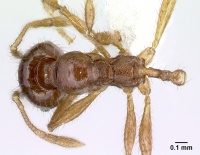Pheidole rhinomontana
| Pheidole rhinomontana | |
|---|---|
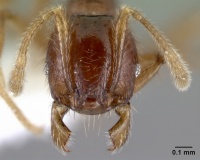
| |
| Scientific classification | |
| Kingdom: | Animalia |
| Phylum: | Arthropoda |
| Class: | Insecta |
| Order: | Hymenoptera |
| Family: | Formicidae |
| Subfamily: | Myrmicinae |
| Tribe: | Attini |
| Genus: | Pheidole |
| Species: | P. rhinomontana |
| Binomial name | |
| Pheidole rhinomontana Longino, 2009 | |
This species inhabits mature montane wet forest habitats, from 500-1600m elevation. Workers are frequently visitors at baits on the ground and are common in Winkler samples of sifted leaf litter. Nests are in or under dead wood on the ground, often in shallow chambers near the surface or under loose bark. Incipient colonies with single queens are often encountered, and colonies can become quite populous. (Longino 2009)
Identification
With the habitus and morphometric profile of Pheidole rhinoceros. Minor worker: katepisternum largely foveolate versus smooth and shining (rhinoceros). Major worker: basal one third to one half of mandible coarsely striate versus largely smooth and shining; clypeus usually with longitudinal to oblique rugulae lateral to medial horn versus clypeus completely smooth and shining lateral to medial horn (rhinoceros). (Longino 2009)
Distribution
Latitudinal Distribution Pattern
Latitudinal Range: 15.0969704° to 8.783333333°.
| North Temperate |
North Subtropical |
Tropical | South Subtropical |
South Temperate |
- Source: AntMaps
Distribution based on Regional Taxon Lists
Neotropical Region: Costa Rica (type locality), Honduras, Nicaragua.
Distribution based on AntMaps
Distribution based on AntWeb specimens
Check data from AntWeb
Countries Occupied
| Number of countries occupied by this species based on AntWiki Regional Taxon Lists. In general, fewer countries occupied indicates a narrower range, while more countries indicates a more widespread species. |

|
Estimated Abundance
| Relative abundance based on number of AntMaps records per species (this species within the purple bar). Fewer records (to the left) indicates a less abundant/encountered species while more records (to the right) indicates more abundant/encountered species. |

|
Biology
Castes
Worker
Minor
Images from AntWeb
   
| |
| Paratype Pheidole rhinomontana. Worker. Specimen code casent0610083. Photographer John T. Longino, uploaded by California Academy of Sciences. | Owned by INBC. |
 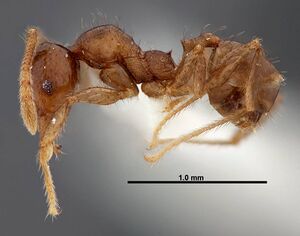  
| |
| Paratype Pheidole rhinomontana. Worker. Specimen code inbiocri002279575. Photographer Stephanie Ware, uploaded by Field Museum. | Owned by FMNH. |
Major
Images from AntWeb
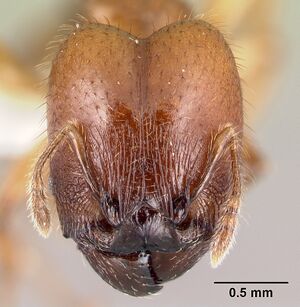 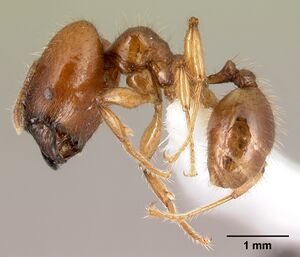  
| |
| Paratype of Pheidole rhinomontana. Worker (major/soldier). Specimen code casent0610078. Photographer Erin Prado, uploaded by California Academy of Sciences. | Owned by CAS, San Francisco, CA, USA. |
    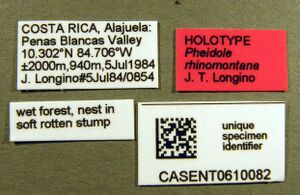
| |
| Holotype Pheidole rhinomontana. Worker (major/soldier). Specimen code casent0610082. Photographer John T. Longino, uploaded by California Academy of Sciences. | Owned by INBC. |
 
| |
| Worker (major/soldier). Specimen code casent0610081. Photographer J. Longino, uploaded by University of Utah. | Owned by JTLC. |
Nomenclature
The following information is derived from Barry Bolton's Online Catalogue of the Ants of the World.
- rhinomontana. Pheidole rhinomontana Longino, 2009: 71, fig. 20 (s.w.) COSTA RICA.
Unless otherwise noted the text for the remainder of this section is reported from the publication that includes the original description.
Wilson discussed character variation in a broadly-defined Pheidole rhinoceros (Wilson 2003). New evidence supports the existence of two sharply parapatric species that separate by elevation. The morphological differences outlined in the Diagnosis (see the identification section of this webpage ) are subtle but consistent. There are now two known areas where the two species co-occur in the same forest. On the Atlantic slope of the Cordillera de Tilarán in Costa Rica, both species were collected at a single bait line at the Poco Sol field station at the lower end of the Peñas Blancas valley, at 800m elevation. At Refugio Eladio, further up the valley but at about the same elevation, extensive collections have yielded only P. rhinomontana. In Monteverde, in the cloudforest-covered ridges that rise to 1800m at the head of the valley, only P. rhinomontana occurs. On the Barva Transect on the Atlantic slope of the Cordillera Volcánica Central, P. rhinoceros is common from La Selva Biological Station at 50m to the El Ceibo Station at 500m. Both species co-occur at this elevation. At the 1070m station and above only P. rhinomontana occurs. This pattern may also occur as far north as Honduras and south into Panama. Although specimen data were not captured, a visit to the MCZ revealed Honduras specimens of P. rhinoceros from a 650m elevation site and Honduras specimens of P. rhinomontana from a 1040m elevation site. In Panama, the type specimens of P. rhinoceros are from Bugaba, below 500m elevation, while the MCZ specimens of P. rhinomontanus examined by Wilson were from Volcán Chiriquí, 900m, and Cerro Campana, 800-950m.
Description
Worker
Minor Measurements (paratype): HL 0.60, HW 0.56, HLA 0.21, SL 0.55, EL 0.11, ML 0.77, PSL 0.03, PMG 0.00, SPL 0.03, PTW 0.08, PPW 0.14, CI 94, SI 97, PSLI 5, PMGI 0, SPLI 5, PPI 175.
Measurements (n=9): HL 0.54-0.65, HW 0.50-0.60, SL 0.50-0.59, CI 90-94, SI 97-105.
Mandible smooth and shining; clypeus smooth and shining with faint medial longitudinal carina; face largely smooth and shining with variable degree of concentric carinulae around antennal insertion and faint foveolate sculpture between frontal carinae and compound eye; margin of vertex rounded with slight median impression; occipital carina narrow, not or barely visible in full face view; scape with abundant erect setae, longest about as long as maximum width of scape; promesonotal groove absent; propodeal spines present; pronotum smooth and shiny dorsally and laterally, with foveolae on humerus and strip of foveolae and transverse carinulae anterodorsally; katepisternum largely to entirely foveolate; sides and dorsum of propodeum foveolate; abundant setae on promesonotal dorsum; dorsal (outer) margin of hind tibia with abundant suberect setae, longest about as long as maximum width of tibia; first gastral tergum smooth and shining; gastral dorsum with abundant erect setae; color red brown.
Major Measurements (holotype): HL 1.55, HW 1.32, HLA 0.40, SL 0.64, EL 0.17, ML 1.33, PSL 0.09, PMG 0.01, SPL 0.05, PTW 0.21, PPW 0.38, IHT 0.21, OHT 0.58, CI 85, SI 48, PSLI 6, PMGI 1, SPLI 3, PPI 180, HTI 35.
Measurements (n=10): HL 1.29-1.74, HW 1.12-1.44, SL 0.60-0.71, CI 83-87, SI 48-53.
Mandible with coarse longitudinal rugae on basal one third to one half, remaining surface smooth; medial clypeus forming a differentiated, somewhat concave surface, sharply delimited by strong oblique carinae extending from anterior apices of frontal carinae; clypeus obsolete or absent lateral to these carinae, not differentiated from coarsely rugose anterior head capsule; medial clypeus with a pronounced acute laminar horn; usually with several weak longitudinal to oblique carinulae on the clypeal surface lateral to horn; anterior clypeal margin flat to weakly emarginate; anterolateral head capsule with longitudinal rugae, grading to reticulate rugae over foveolae between antennal insertion and compound eye, grading to faint foveolate sculpture on scrobal area beneath scapes, grading to smooth and shining on vertex lobes; area between frontal carinae with longitudinal carinulae; head with abundant suberect setae projecting from sides of head in face view; scape smooth and shining, terete at base, with abundant erect setae about as long as maximum width of scape; hypostomal margin flat; median tooth absent; inner hypostomal teeth pointed, stout, closer to midline than to outer hypostomal teeth; promesonotal groove absent; propodeal spines present; mesosoma largely smooth and shining, with faint transverse etchings on pronotum, faint foveolate sculpture on dorsal face of propodeum; dorsal (outer) margin of hind tibia with abundant erect setae, these not quite as long as maximum width of tibia; pilosity abundant on mesosomal dorsum; postpetiolar dorsum smooth and shining, in dorsal view broader than long, weakly conulate; first gastral tergite smooth and shining, with abundant erect setae; color red brown.
Type Material
Holotype major worker. Costa Rica, Alajuela: Peñas Blancas Valley, Guindon cabin, 10.30000°N 84.70000°W, ±2000m, 940m, 5 Jul 1984 (J. Longino#5Jul84/0854) Instituto Nacional de Biodiversidad, unique specimen identifier CASENT0610082.
Paratypes: major and minor workers. Same data as holotype The Natural History Museum, California Academy of Sciences, Field Museum of Natural History, Instituto Nacional de Biodiversidad, Los Angeles County Museum of Natural History, Museum of Comparative Zoology, Musee d'Histoire Naturelle Genève, Instituto de Zoologia Agricola, Museu de Zoologia da Universidade de Sao Paulo, University of California, Davis, ICN, National Museum of Natural History.
Etymology
The name is in reference to this species being a montane version of P. rhinoceros.
References
- Longino, J.T. 2009. Additions to the taxonomy of New World Pheidole. Zootaxa 2181: 1-90. PDF
References based on Global Ant Biodiversity Informatics
- Longino J. T. 2009. Additions to the taxonomy of New World Pheidole (Hymenoptera: Formicidae). Zootaxa 2181: 1-90.
- Longino J. T. 2013. Ants of Honduras. Consulted on 18 Jan 2013. https://sites.google.com/site/longinollama/reports/ants-of-honduras
- Longino J. T. 2013. Ants of Nicargua. Consulted on 18 Jan 2013. https://sites.google.com/site/longinollama/reports/ants-of-nicaragua
- Longino J. T. L., and M. G. Branstetter. 2018. The truncated bell: an enigmatic but pervasive elevational diversity pattern in Middle American ants. Ecography 41: 1-12.
- Longino J. et al. ADMAC project. Accessed on March 24th 2017 at https://sites.google.com/site/admacsite/
- Smith M. A., W. Hallwachs, D. H. Janzen. 2014. Diversity and phylogenetic community structure of ants along a Costa Rican elevational gradient. Ecography 37(8): 720-731.

